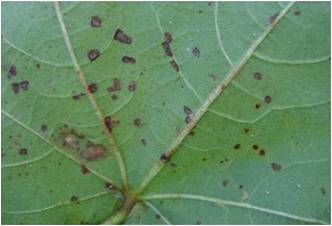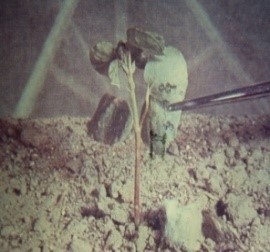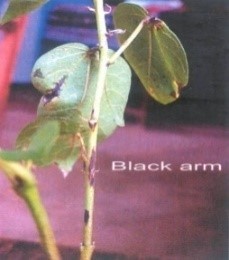Symptom
The bacterium attacks all stages from seed to harvest.
Five common phases of symptoms
1. Seedling blight
-
Small, water-soaked, circular or irregular lesions on the cotyledons.
-
Infection spreads to stem through petiole and cause withering and death of seedlings.
2. Angular Leaf Spot
-
Small, dark green, water soaked areas develop on lower surface of leaves.
-
The spots become angular restricted by veins and veinlets and are visible on both the surface of leaves.
-
Later they turn reddish brown colour and infection spreads to veins and veinlets.
3.Vein necrosis or Vein banding
-
Blackening of the veins and veinlets, gives a typical ‘blighting’ appearance.
-
On the lower surface of the leaf, bacterial oozes are formed as crusts or scales.
-
The leaves become crinkled and twisted inward and show withering.
-
The infection also spreads from veins to petiole and cause blighting leading to defoliation.
4. Blackarm
-
On the stem and fruiting branches, dark brown to black lesions are formed.
-
Girdle the stem and branches to cause premature drooping off of the leaves.
-
Cracking of stem and gummosis, resulting in breaking of the stem and hang typically as dry black twig to give a characteristic “black arm” symptom.
5. Square rot or boll rot
-
On the bolls, water soaked lesions appear and turn into dark black and sunken irregular spots.
-
Infection slowly spreads to entire boll and shedding occurs.
-
Infection on mature bolls lead to premature bursting.
-
The bacterium spreads inside the boll and lint gets stained yellow because of bacterial ooze and loses its appearance and market value.
-
The pathogen also infects the seed and causes reduction in size and viability of the seeds.
Survival and Mode of Spread
-
The bacterium survives on infected, dried plant debris in soil for several years. The bacterium is also seed-borne and remains in the form of slimy mass on the fuzz of seed coat.
-
The primary infection is through seed-borne bacterium.
-
Secondary spread is through wind, windblown rain splash, irrigation water, insects and other implements.
Favourable Conditions
-
Optimum soil temperature of 28˚C,
-
High atmospheric temperature of 30-40˚C,
-
Relative humidity of 85 per cent
-
Poor tillage, late irrigation
-
Potassium deficiency in soil.
-
Rain followed by bright sunshine during the months of October and November.
Management
-
Delint the cotton seeds with concentrated sulphuric acid at 100ml/kg of seed.
-
Treat the delinted seeds with Carboxin or Oxycarboxin at 2 g/kg or Carboxin 37.5% + Thiram 37.5% WS @2.5 g/ kg
-
Remove and destroy the infected plant debris.
-
Rogue out the volunteer cotton plants and weed hosts.
-
Follow crop rotation with non-host crops.
-
Early thinning and early earthing up with potash.
-
Spray Streptomycin sulphate @ 100g +Copper oxychloride@500 g/acre
|
 |
 |
| Angular leaf spot |
Vein necrosis |
| Boll rot |
 |
 |
| Seedling blight |
Blackarm |
 |
| Square and Boll Rot |
|





